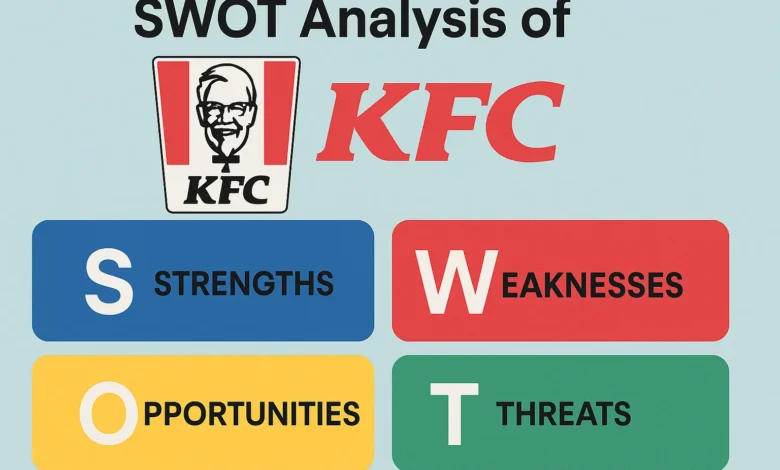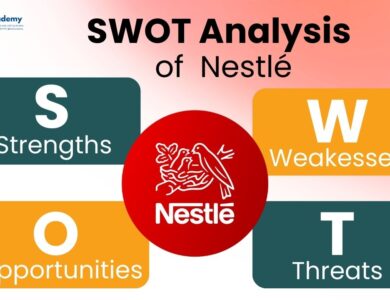SWOT Analysis of KFC: Strengths, Weaknesses, Opportunities & Threats Explained
"Understand how KFC leverages its global reach while facing competitive threats and operational weaknesses in this comprehensive SWOT breakdown."

When you think of fried chicken, one name instantly comes to mind—KFC. With its legendary “Original Recipe” and global red-and-white branding, KFC has become a symbol of fast food excellence across the world.
But what lies behind its crispy coating of success? How does the brand continue to thrive in such a competitive industry?
That’s where a SWOT analysis comes in—an effective tool to explore a brand’s internal strengths and weaknesses, along with external opportunities and threats.
Whether you’re a business student, marketer, or just curious about what keeps KFC ticking, this analysis will give you a clear, strategic view of how the brand operates on a global scale.
From its iconic branding and franchising model to the challenges of changing food habits, we’ll break down everything that defines KFC’s current market position—and where it might be headed next.
So let’s dive deep into the world of this global fried chicken powerhouse.
Also Read: SWOT Analysis of Maggi Noodles: From Instant Fame to Brand Challenges
Company Overview of KFC
KFC, short for Kentucky Fried Chicken, began its journey in 1930 when Colonel Harland Sanders started selling his signature fried chicken from a roadside restaurant in Corbin, Kentucky.
What started as a small-town venture quickly grew into a global fast-food empire, thanks to Sanders’ famous “11 herbs and spices” recipe that still remains a closely guarded secret today.
Now a subsidiary of Yum! Brands Inc., KFC operates over 25,000 restaurants in more than 145 countries, making it one of the largest fast-food chains in the world.
Known primarily for its crispy fried chicken, KFC has continually adapted to local tastes with region-specific menus, such as spicy chicken in India or rice bowls in Asia.
The brand stands out for its franchise-first business model, massive advertising footprint, and deep cultural relevance—especially in regions where fried chicken is a festive or comfort food.
With a mix of traditional offerings and modern innovations, KFC continues to be a key player in the quick-service restaurant (QSR) industry.
Also Read: Lakmé SWOT Breakdown: How the Brand Rules India’s Beauty Market
Strengths of KFC
Every global brand has something special that keeps it thriving in a sea of competition. For KFC, success isn’t just about fried chicken—it’s about a powerful brand formula built on consistency, innovation, and strategic expansion. Let’s explore the key strengths that fuel KFC’s dominance in the fast-food industry.
1. Globally Recognized Brand with Loyal Following
KFC’s red-and-white logo, paired with Colonel Sanders’ smiling face, is instantly recognizable in over 145 countries.
Its brand equity is so strong that in many parts of the world, “KFC” is synonymous with fried chicken. This massive brand recall gives it a huge advantage in customer acquisition and retention.
2. Iconic Secret Recipe and Product Differentiation
KFC’s “Original Recipe” with 11 herbs and spices is more than a marketing slogan—it’s a tightly held secret that sets its chicken apart from competitors. This unique flavor profile has helped the brand maintain a competitive edge while offering a taste that’s both nostalgic and exclusive.
3. Scalable and Proven Franchise Model
With the majority of its outlets operated by franchisees, KFC has created a scalable and cost-efficient growth model. Franchise partners receive access to a globally trusted system, and the brand benefits from fast expansion with lower capital investment.
4. Strong Parent Company Support (Yum! Brands)
Being part of Yum! Brands (alongside Pizza Hut and Taco Bell) gives KFC access to shared resources, cross-brand promotions, advanced analytics, and international supply chain infrastructure. This support strengthens its global consistency while allowing local-level customization.
5. Menu Localization and Cultural Adaptation
Unlike some competitors that stick to a one-size-fits-all model, KFC is known for adapting its menu to local tastes. From Paneer Zinger in India to Teriyaki chicken bowls in Japan, KFC respects cultural preferences—helping it feel local in global markets.
6. Consistent Marketing and Emotional Branding
KFC has mastered the art of emotional and nostalgic marketing. Its campaigns often celebrate tradition, comfort food, and family meals—creating a brand identity that goes beyond fast food. Regular reinvention through humor, social media, and pop culture also keeps it fresh in younger audiences’ minds.
In short, KFC’s strengths lie in more than just its crispy chicken. Its global vision, local adaptability, and legendary brand story make it a powerhouse in the quick-service restaurant industry.
Also Read: Complete SWOT Analysis of Bajaj – From Two-Wheelers to Global Exports
Weaknesses of KFC
No matter how iconic a brand is, every business has its blind spots—and for KFC, these weaknesses can limit its ability to grow, adapt, or maintain a consistent customer experience across markets. Let’s take a closer look at the key internal challenges KFC faces today.
1. Health Concerns Around Fried Food
One of the biggest challenges for KFC is its heavy reliance on deep-fried offerings. In an era where consumers are shifting toward healthier lifestyles, the brand’s core menu may appear outdated or unhealthy, especially to health-conscious millennials and Gen Z audiences.
2. Limited Menu Diversity Compared to Competitors
While KFC excels in chicken-based items, it often lacks the diverse product range seen in brands like McDonald’s or Subway. This narrower focus can limit appeal for vegetarian customers or those seeking low-calorie or plant-based alternatives, especially in culturally sensitive markets like India.
3. Inconsistent Customer Experience Across Locations
Due to its vast global franchising network, KFC struggles with standardized service and food quality. Customer experience can vary significantly depending on the region or even the specific outlet, which impacts brand trust and repeat business.
4. Negative Perception of Fast Food Industry
As part of the fast-food ecosystem, KFC is often grouped with concerns around obesity, processed ingredients, and ethical food practices. These perceptions—even if not entirely accurate—can tarnish the brand’s image, especially in markets where awareness around nutrition is rising.
5. High Employee Turnover in Franchise Locations
Like most QSR chains, KFC experiences high staff turnover, especially at the crew and management level in its outlets. This can affect service quality, increase training costs, and weaken the customer-service experience over time.
While these weaknesses don’t undermine KFC’s global influence, they are crucial areas the brand needs to address in order to stay competitive and aligned with modern consumer expectations.
Also Read: In-Depth SWOT Analysis of Axis Bank – India’s Leading Private Sector Bank
Opportunities for KFC
In a rapidly changing world, even established brands like KFC must look ahead and tap into emerging trends, technologies, and markets. Fortunately, there are several exciting opportunities for KFC to strengthen its global footprint and stay relevant in the modern fast-food scene.
1. Expansion into Emerging Markets
Countries across Africa, Southeast Asia, and Eastern Europe present untapped potential for KFC. Rising urbanization, a growing middle class, and increasing demand for Western-style food make these regions ideal for expansion, especially with localized menus and smart pricing strategies.
2. Growth of Online Ordering & Cloud Kitchens
The pandemic accelerated a massive shift toward online food delivery. KFC can continue to ride this wave by scaling cloud kitchens, optimizing delivery-only menus, and partnering with platforms like Swiggy, Zomato, Uber Eats, and DoorDash to capture digital-first customers.
3. Introducing Healthier Menu Options
With the global demand for healthier food choices growing, KFC has the opportunity to introduce baked, grilled, or air-fried chicken items, lower-calorie meals, and balanced combos. A dedicated “healthy menu” could open doors to new customer segments without alienating its core fans.
4. Investing in Plant-Based and Vegan Alternatives
Brands like McDonald’s and Burger King are already testing plant-based meat. KFC has also taken early steps, with products like the Beyond Fried Chicken in select markets. Expanding this innovation globally can help attract vegans, vegetarians, and flexitarians—a fast-growing demographic.
5. Enhancing Sustainability and Ethical Practices
Eco-conscious consumers are demanding more transparency and responsibility. By adopting sustainable packaging, responsible sourcing, and reducing food waste, KFC can improve its public image and appeal to the environmentally aware generation.
6. Leveraging Influencer Marketing and Gen Z Trends
Social-first strategies are a goldmine. KFC can further invest in influencer partnerships, TikTok food trends, and limited-time pop culture meals to engage younger audiences who value experience, humor, and viral content over traditional ads.
These opportunities show that KFC’s future isn’t just about chicken—it’s about evolution. By embracing change while staying true to its core identity, KFC can continue to lead in the ever-competitive quick-service restaurant world.
Also Read: Complete SWOT Analysis of Uber: How It Dominates the Global Mobility Market
Threats to KFC
While KFC enjoys a strong market position, several external factors pose potential risks to its continued success. Understanding these threats is crucial for maintaining its edge and adapting to an ever-changing food industry.
1. Rising Competition from Local and Global QSR Brands
The quick-service restaurant (QSR) market is highly competitive, and KFC faces constant pressure from both global giants like McDonald’s, Burger King, and Subway, as well as emerging local players.
These competitors often have more diverse menus, larger marketing budgets, and greater flexibility to cater to local tastes. As more QSR brands enter emerging markets, the competition for market share intensifies.
2. Changing Consumer Preferences Toward Healthier Options
With consumers becoming more health-conscious, there’s a significant shift toward plant-based diets, low-calorie meals, and clean-label foods.
While KFC has begun experimenting with plant-based options, its core menu of fried chicken may struggle to stay relevant as more customers seek healthier alternatives. Failing to adapt to these changing preferences could alienate a large segment of potential customers.
3. Economic Instability and Inflation
Global economic instability, inflationary pressures, and rising food costs can impact KFC’s pricing strategy. As raw material costs increase, especially for chicken and other key ingredients, KFC may face pressure to either raise prices—which risks losing price-sensitive customers—or absorb the costs, which can squeeze profit margins.
4. Negative Publicity Related to Animal Welfare
As consumers become more aware of animal welfare issues, KFC could face criticism for its sourcing and treatment of animals in its supply chain.
Even though KFC has made efforts to improve ethical sourcing, negative campaigns or scandals could damage its brand image and impact sales, especially in markets that are more socially and environmentally conscious.
5. Regulatory Challenges in International Markets
KFC operates in over 145 countries, each with its own set of regulations around food safety, labor laws, and taxation. New laws or shifts in trade agreements can disrupt operations, especially in regions where the brand faces regulatory hurdles.
Additionally, changes in fast-food regulations (such as limitations on sugar or salt content) could require costly adjustments to KFC’s menu.
6. Rising Popularity of Delivery-Only and Ghost Kitchens
The growth of ghost kitchens and delivery-only platforms presents both an opportunity and a threat. KFC, while expanding into delivery, still relies heavily on traditional brick-and-mortar outlets.
New, leaner, and tech-savvy competitors can deliver food faster and at a lower cost, especially in urban areas, putting pressure on KFC’s traditional business model.
These external threats highlight that KFC must continuously evolve, innovate, and remain aware of global market dynamics to maintain its leadership in the highly competitive food industry.
Also Read: Complete SWOT Analysis of Titan – India’s Leading Watch and Jewelry Brand
Summary of SWOT Matrix
Here’s a quick overview of KFC’s strengths, weaknesses, opportunities, and threats based on our detailed analysis:
Strengths
-
Globally recognized brand with strong customer loyalty
-
Secret recipe and unique product differentiation
-
Proven franchising model for rapid global expansion
-
Backed by Yum! Brands’ resources and infrastructure
-
Culturally adaptive menu tailored to local tastes
-
Strong marketing and emotional brand storytelling
Weaknesses
-
Perception of unhealthy food due to fried-heavy menu
-
Limited vegetarian and health-conscious options
-
Inconsistent service across franchises
-
Negative fast-food industry image
-
High employee turnover at outlet level
Opportunities
-
Expansion into untapped emerging markets
-
Growth in online ordering, delivery apps, and cloud kitchens
-
Demand for healthier and plant-based meal options
-
Emphasis on sustainability and ethical food sourcing
-
Collaborations with influencers and Gen Z engagement strategies
Threats
-
Rising competition from global and regional QSR brands
-
Shifting consumer preference toward health and wellness
-
Economic instability, inflation, and supply chain disruptions
-
Animal welfare concerns and regulatory scrutiny
-
New digital-first players using ghost kitchen models
Strategic Insights & Conclusion
KFC’s journey from a humble roadside diner in Kentucky to one of the most recognized fast-food brands in the world is nothing short of legendary. But in today’s hyper-competitive, health-conscious, and digitally-driven market, legacy alone isn’t enough to sustain leadership.
The SWOT analysis reveals that KFC’s biggest assets lie in its brand loyalty, global reach, and product uniqueness. However, as customer preferences shift and new players enter the scene, the brand must actively evolve. Embracing healthier menu innovations, expanding in digital-first markets, and investing in sustainability and ethical sourcing will be crucial for long-term success.
The good news? KFC is no stranger to reinvention. From adapting local menus to launching plant-based products and tapping into influencer culture, the brand has shown it’s capable of moving with the times.
In the end, the brands that win aren’t just those with great food—but those that listen to consumers, adapt quickly, and build emotional relevance. For KFC, the recipe for future success lies not just in its 11 secret herbs and spices, but in its ability to stay hungry, humble, and ahead of the curve.





